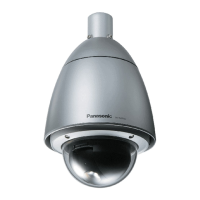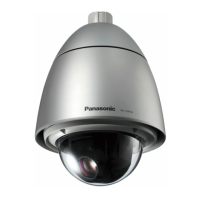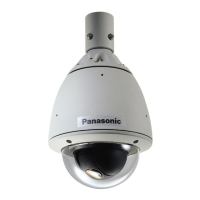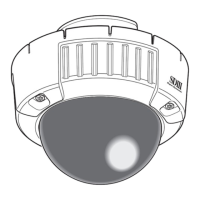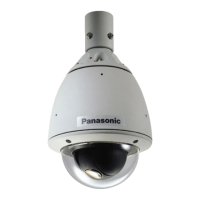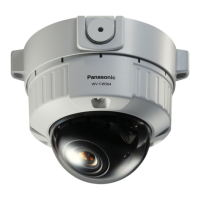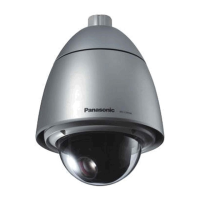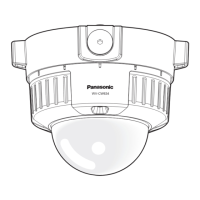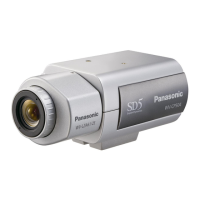Do you have a question about the Panasonic WV-CW964 and is the answer not in the manual?
Advanced image processing for varying illumination levels.
Enhanced low-light performance via noise reduction.
Automatic mode change for clear night vision.
Enables 180° tilt for continuous object tracking.
Masks specific areas to protect privacy.
Stores and replays camera movement sequences.
Stores up to 256 camera positions for quick recall.
Triggers alarms upon detecting movement.
Prevents condensation and frost on the dome.
Details IP66 rating for outdoor protection.
Guidelines for selecting a suitable installation site.
Information on selecting and using mounting hardware.
Instructions for safely connecting power to the camera.
Advice on preventing electrical noise interference.
Warning about potential condensation in humid environments.
Information regarding the camera's built-in heating function.
How environmental factors like rain and snow affect image quality.
Key tips and considerations for a successful installation.
Setting communication protocol parameters via DIP Switch 2.
Assigning a unique unit number using DIP Switch 1.
Configuring RS485 communication settings with DIP Switch 1.
Essential safety and procedural precautions before installation.
Step-by-step guide for mounting the camera assembly.
Instructions for securely attaching the mounting bracket.
Detailed steps for bracket installation.
How to attach the camera to its brackets.
Installing the protective sun shields.
Safety guidelines for making electrical connections.
Specifications for alarm input and output signals.
Details on connecting the 24V AC power source.
Guide for preparing and connecting cables to the accessory connector.
Steps to access and view the main setup menu.
Configuring and displaying unique camera identifiers.
Adjusting camera settings based on predefined scenes.
Selecting and configuring specific camera positions.
Defining specific camera pan, tilt, zoom, and focus settings.
Fine-tuning camera position after system changes.
Setting and displaying identifiers for preset positions.
Selecting the user interface language.
Accessing and configuring advanced camera settings.
How to navigate and utilize the camera's setup menu options.
Setting and displaying unique identifiers for each camera.
Adjusting automatic or manual lens iris control.
Enabling advanced image processing for challenging lighting.
Controlling exposure time by adjusting shutter speed.
Adjusting automatic gain control for image brightness.
Boosting image sensitivity in low-light conditions.
Selecting video synchronization methods.
Fine-tuning video phase alignment for line-lock sync.
Adjusting color balance for accurate representation.
Reducing digital noise in the video feed.
Setting the image resolution for clarity.
Configuring automatic switching to black and white mode.
Selecting and configuring auto-focus operational modes.
Setting the maximum zoom range for the camera.
Compensating for camera shake or vibration.
Navigating the menu for pan/tilt adjustments.
Choosing preset positions for camera movement.
Selecting positions via a map interface.
Defining specific camera pan, tilt, zoom, and focus settings.
Fine-tuning camera position after system changes.
Assigning and displaying identifiers for preset positions.
Adjusting lens iris for optimal brightness.
Selecting and configuring auto-focus modes.
Setting pause duration for sequence/sort operations.
Storing and applying specific scene configurations.
Configuring the speed for preset camera movements.
Removing stored preset camera positions.
Designating a default position for the camera.
Configuring automatic return to modes after inactivity.
Selecting automated camera movement behaviors.
Detailed configuration for automated panning sequences.
Assigning operations to the AUTO PAN key.
Recording and playing back sequences of camera movements.
Defining masked areas within the camera's view.
Freezing the image until camera movement is complete.
Inverting image for tracking objects directly below.
Adjusting pan/tilt speed based on zoom level.
Displaying directional indicators or custom text overlays.
Setting the camera's tilt angle limits.
Activating the slip ring cleaning function.
Navigating the alarm configuration menu.
Setting up motion detection parameters for alarms.
Fine-tuning motion detection sensitivity and areas.
Triggering alarms upon completion of preset movements.
Defining actions for specific alarm inputs and outputs.
Accessing and navigating the special setup options.
Fine-tuning color, aperture, pedestal, and hue settings.
Configuring what information is shown on the display.
Correcting defective pixels for cleaner images.
Recalibrating camera position to correct deviations.
Resetting all configurable settings to factory defaults.
Navigating the scene selection menu.
Applying predefined scene settings to the camera.
Enabling and configuring the password lock feature.
Activating or deactivating the password protection.
Procedure for modifying the password lock.
Solutions for a completely dark or blank screen.
Solutions for an overly white or blown-out image.
Solutions for images that are not sharply focused.
Solutions for grainy or noisy video output.
Solutions for inaccurate or washed-out colors.
Solutions for intermittent flickering in the video feed.
Solutions for persistent ghost images or trails.
Solutions for the camera defaulting to black and white mode.
Solutions for rapid or unwanted mode changes.
Solutions for small white spots appearing in the image.
Explanation for a specific visual artifact in certain orientations.
Solutions for being unable to access the setup menus.
Solutions when camera settings cannot be modified.
Procedure if the password lock password is forgotten.
Solutions for issues with automatic B/W mode switching.
Solutions for unresponsive camera movement controls.
Solutions for automated movement mode failures.
Solutions when automated movement mode settings change unexpectedly.
Solutions for discrepancies between set and actual camera positions.
Solutions for image appearance differing from expected position settings.
Explanation for a black band at the top of the image in certain orientations.
Solutions for unexpected automatic camera panning.
Overview of general technical parameters.
Specifications related to pan and tilt movements.
Technical specifications of the camera lens.
Summary list of the camera's primary operational functions.
Advanced image processing for varying illumination levels.
Enhanced low-light performance via noise reduction.
Automatic mode change for clear night vision.
Enables 180° tilt for continuous object tracking.
Masks specific areas to protect privacy.
Stores and replays camera movement sequences.
Stores up to 256 camera positions for quick recall.
Triggers alarms upon detecting movement.
Prevents condensation and frost on the dome.
Details IP66 rating for outdoor protection.
Guidelines for selecting a suitable installation site.
Information on selecting and using mounting hardware.
Instructions for safely connecting power to the camera.
Advice on preventing electrical noise interference.
Warning about potential condensation in humid environments.
Information regarding the camera's built-in heating function.
How environmental factors like rain and snow affect image quality.
Key tips and considerations for a successful installation.
Setting communication protocol parameters via DIP Switch 2.
Assigning a unique unit number using DIP Switch 1.
Configuring RS485 communication settings with DIP Switch 1.
Essential safety and procedural precautions before installation.
Step-by-step guide for mounting the camera assembly.
Instructions for securely attaching the mounting bracket.
Detailed steps for bracket installation.
How to attach the camera to its brackets.
Installing the protective sun shields.
Safety guidelines for making electrical connections.
Specifications for alarm input and output signals.
Details on connecting the 24V AC power source.
Guide for preparing and connecting cables to the accessory connector.
Steps to access and view the main setup menu.
Configuring and displaying unique camera identifiers.
Adjusting camera settings based on predefined scenes.
Selecting and configuring specific camera positions.
Defining specific camera pan, tilt, zoom, and focus settings.
Fine-tuning camera position after system changes.
Setting and displaying identifiers for preset positions.
Selecting the user interface language.
Accessing and configuring advanced camera settings.
How to navigate and utilize the camera's setup menu options.
Setting and displaying unique identifiers for each camera.
Adjusting automatic or manual lens iris control.
Enabling advanced image processing for challenging lighting.
Controlling exposure time by adjusting shutter speed.
Adjusting automatic gain control for image brightness.
Boosting image sensitivity in low-light conditions.
Selecting video synchronization methods.
Fine-tuning video phase alignment for line-lock sync.
Adjusting color balance for accurate representation.
Reducing digital noise in the video feed.
Setting the image resolution for clarity.
Configuring automatic switching to black and white mode.
Selecting and configuring auto-focus operational modes.
Setting the maximum zoom range for the camera.
Compensating for camera shake or vibration.
Navigating the menu for pan/tilt adjustments.
Choosing preset positions for camera movement.
Selecting positions via a map interface.
Defining specific camera pan, tilt, zoom, and focus settings.
Fine-tuning camera position after system changes.
Assigning and displaying identifiers for preset positions.
Adjusting lens iris for optimal brightness.
Selecting and configuring auto-focus modes.
Setting pause duration for sequence/sort operations.
Storing and applying specific scene configurations.
Configuring the speed for preset camera movements.
Removing stored preset camera positions.
Designating a default position for the camera.
Configuring automatic return to modes after inactivity.
Selecting automated camera movement behaviors.
Detailed configuration for automated panning sequences.
Assigning operations to the AUTO PAN key.
Recording and playing back sequences of camera movements.
Defining masked areas within the camera's view.
Freezing the image until camera movement is complete.
Inverting image for tracking objects directly below.
Adjusting pan/tilt speed based on zoom level.
Displaying directional indicators or custom text overlays.
Setting the camera's tilt angle limits.
Activating the slip ring cleaning function.
Navigating the alarm configuration menu.
Setting up motion detection parameters for alarms.
Fine-tuning motion detection sensitivity and areas.
Triggering alarms upon completion of preset movements.
Defining actions for specific alarm inputs and outputs.
Accessing and navigating the special setup options.
Fine-tuning color, aperture, pedestal, and hue settings.
Configuring what information is shown on the display.
Correcting defective pixels for cleaner images.
Recalibrating camera position to correct deviations.
Resetting all configurable settings to factory defaults.
Navigating the scene selection menu.
Applying predefined scene settings to the camera.
Enabling and configuring the password lock feature.
Activating or deactivating the password protection.
Procedure for modifying the password lock.
Solutions for a completely dark or blank screen.
Solutions for an overly white or blown-out image.
Solutions for images that are not sharply focused.
Solutions for grainy or noisy video output.
Solutions for inaccurate or washed-out colors.
Solutions for intermittent flickering in the video feed.
Solutions for persistent ghost images or trails.
Solutions for the camera defaulting to black and white mode.
Solutions for rapid or unwanted mode changes.
Solutions for small white spots appearing in the image.
Explanation for a specific visual artifact in certain orientations.
Solutions for being unable to access the setup menus.
Solutions when camera settings cannot be modified.
Procedure if the password lock password is forgotten.
Solutions for issues with automatic B/W mode switching.
Solutions for unresponsive camera movement controls.
Solutions for automated movement mode failures.
Solutions when automated movement mode settings change unexpectedly.
Solutions for discrepancies between set and actual camera positions.
Solutions for image appearance differing from expected position settings.
Explanation for a black band at the top of the image in certain orientations.
Solutions for unexpected automatic camera panning.
Overview of general technical parameters.
Specifications related to pan and tilt movements.
Technical specifications of the camera lens.
Summary list of the camera's primary operational functions.
| power requirements | 24 V AC, 60 Hz |
|---|---|
| power consumption for camera | 17 W |
| power consumption for heater | 62 W |
| ambient operating temperature | -40 °C ~ +50 °C |
|---|---|
| ambient operating humidity | 90 % max. (non-condensation) |
| water resistance | IP66 |
| pick-up device | 1/4-type interline transfer CCD |
|---|---|
| effective pixels | 768 (H) x 494 (V) |
| resolution center horizontal | 480 TV lines minimum (color NORMAL mode) |
| zoom ratio | 30x (approx. 300x with digital zoom) |
|---|---|
| focal length | 3.8 mm ~ 114 mm |
| maximum aperture ratio | 1:1.4 (WIDE) ~ 3.6 (TELE) |
| dimensions | ø239 mm (D) x 395.5 mm (H) |
|---|---|
| weight | approx. 4.7 kg |
| scanning area | 3.65 mm (H) x 2.74 mm (V) |
